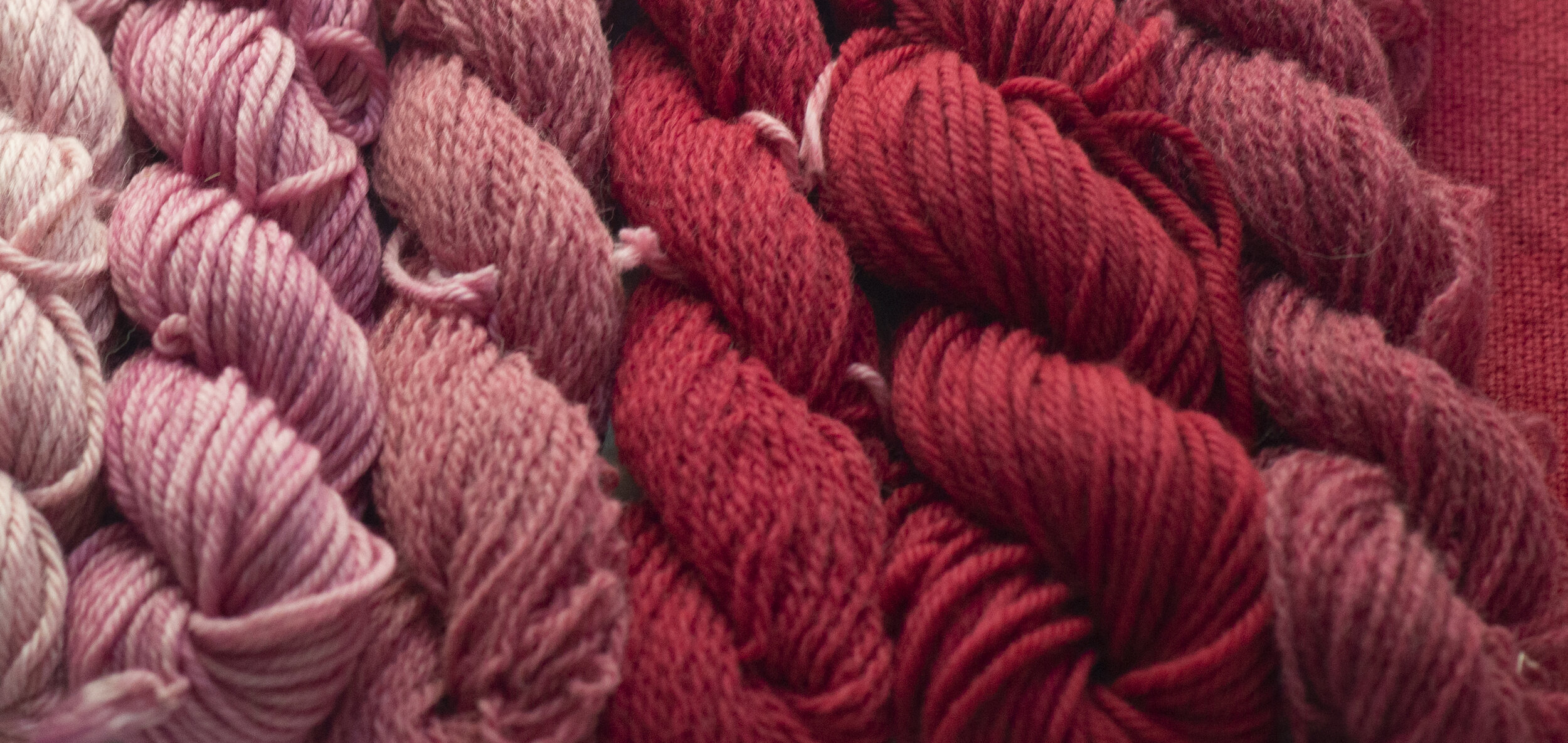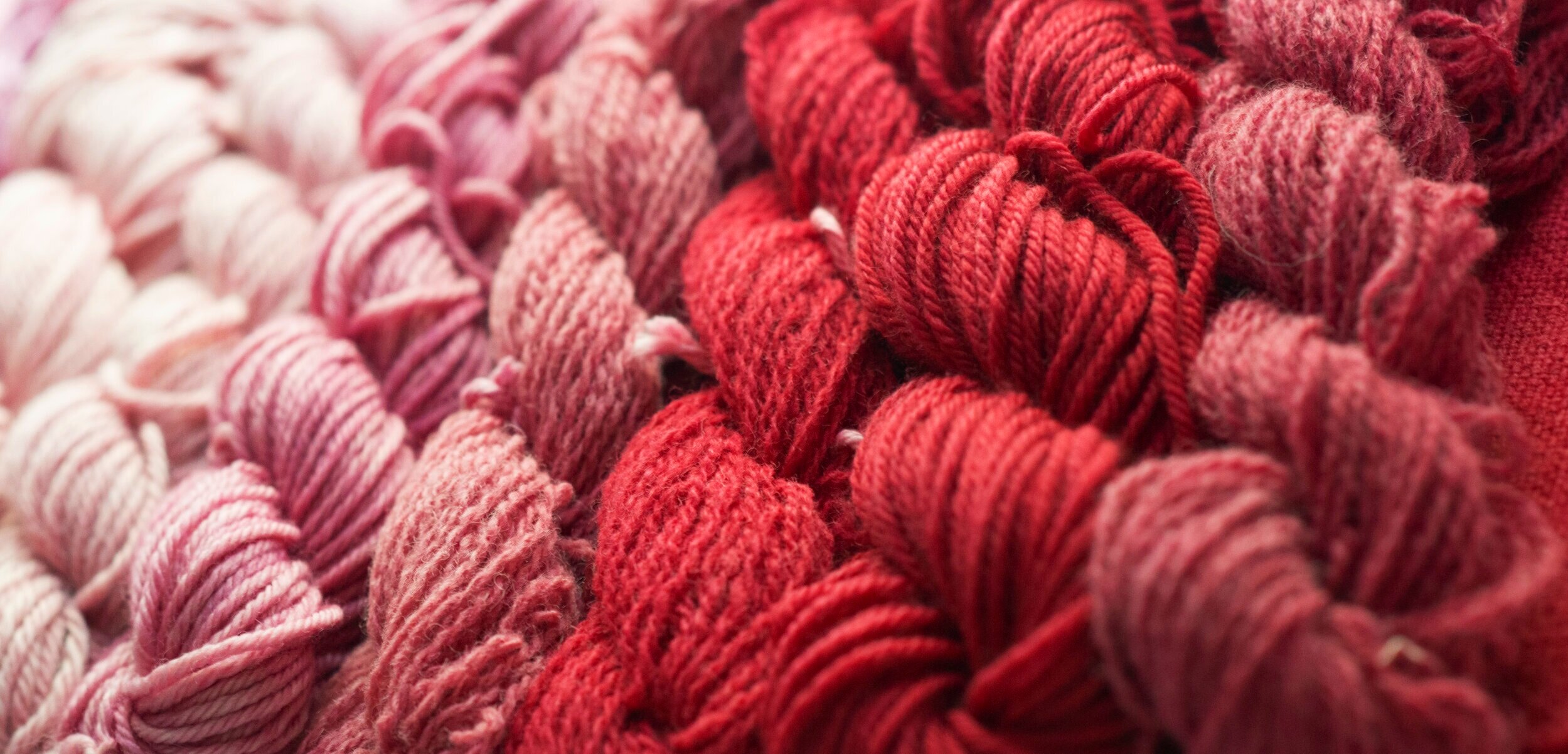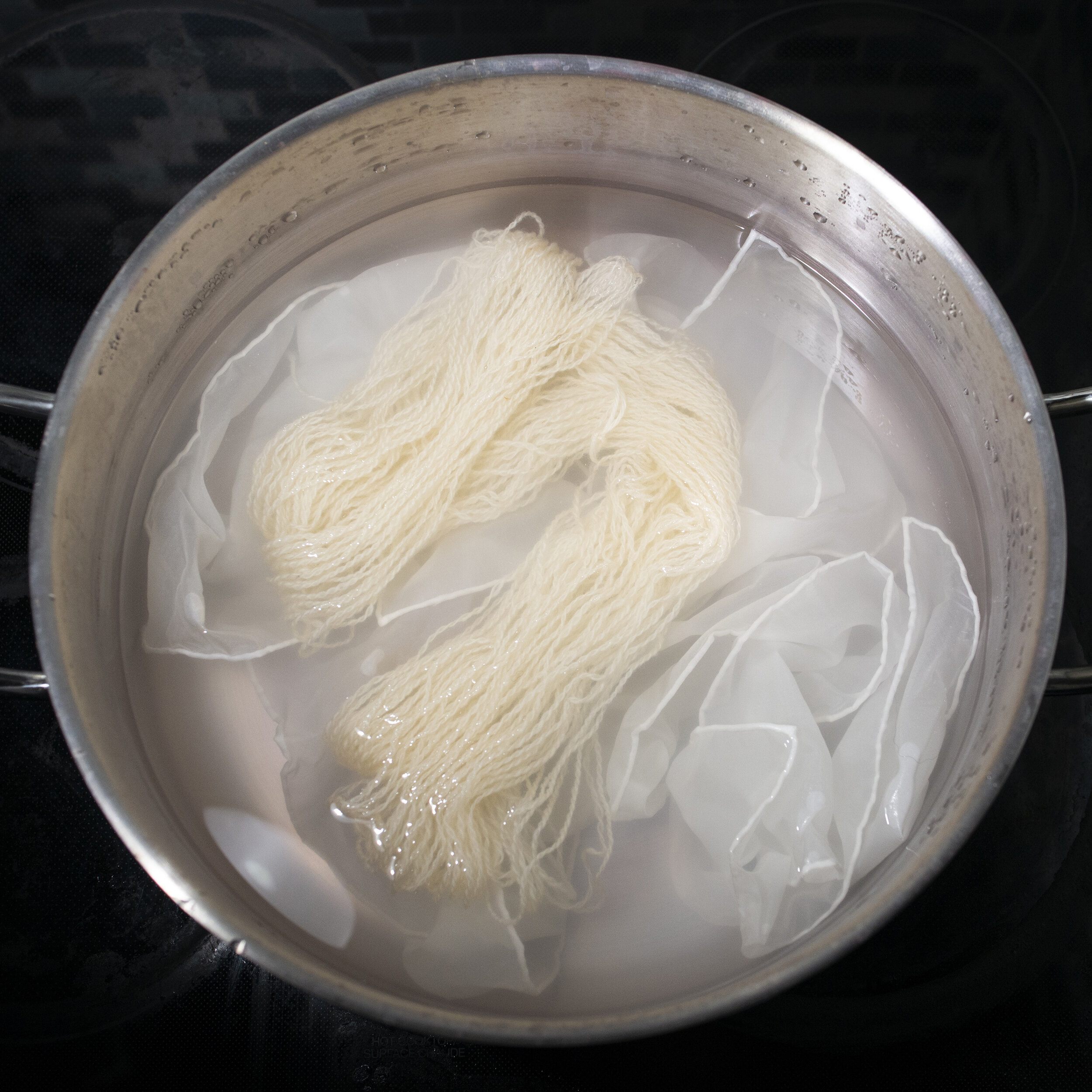
Cochineal Extract Carmine
A Guide to Cochineal Extract Carmine
Shepherd Textiles Cochineal Extract Carmine is produced on the same farm in Peru that supplies our dried cochineal. Carmine is the traditional form of cochineal extract and it has been used by dyers since the 17th century. Cochineal Extract Carmine can produce deep reds on animal fibers like wool and silk. However, because it is produced by precipitating carminic acid with aluminum, it is not entirely soluble except at high pH and does not work well with cotton or alternate mordants. Please note that we have recently released a new form of Peruvian cochineal extract called Cochineal Extract C.A. Plus™ which contains carminic acid in its most soluble form. We recommend using the new C.A. Plus extract for dyeing textiles, since it is easier to dissolve, easier to apply, and produces results more similar to raw cochineal. However, if you prefer to try the historical form of Cochineal Extract Carmine, please see the recipes and tips below.
1. Background on Cochineal
The cochineal or grana is a scale insect (dactylopius coccus) that lives out its life on cactus pads. The female produces a bright red substance called carminic acid to discourage predation. Carminic acid also happens to be an excellent textile dye that produces color-fast, light-fast reds and purples. The cultivation of cochineal for this purpose dates to the pre-Hispanic era in Mexico. In Nahua the insect was called nocheztli, which means blood-of-the-cactus (see Bassett and Peterson 2012:48). It was a common tribute item sent by the rural provinces to the capital, and Europeans first encountered it in the 16th century in the grand markets of Tenochtitlan. Cochineal, along with silver and logwood, quickly became one of the most lucrative exports of New Spain. The Spanish prohibited export of the live insects and maintained a monopoly on cochineal until the beginning of the 19th century. After the Mexican Revolution a few bugs were smuggled to Spain’s Canary Islands, but the industry there collapsed when synthetic red dyes were invented just a few decades later. Today cochineal is primarily produced in the high deserts of Peru, where the climate is ideal for growing the cacti that cochineal need to survive.
Cochineal is available in a wide variety of forms, including many extracts produced with different colors, strengths, and purposes. The oldest and best-known form of cochineal extract is called carmine. Carmine is simply carminic acid that has been solidified as a pigment or color lake, often with alum, although a variety of different methods are used some of which are very different from the methods used to produce plant-based pigments (see discussion in Crookes 1874:358-360). Carmine seems to have been invented by a Franciscan monk in Italy and it was well known in Europe by the middle of the seventeenth century, where it was chiefly employed for printing calicos and dyeing thin silks (ibid:359). The advantage of carmine is that it expresses the bright red color of cochineal combined with aluminum (pure carminic acid is a dull brown-purple color); the disadvantage of carmine is that, since it is a pigment or lake, it is not entirely soluble except at high pH and it does not work well with mordants other than alum. Nonetheless, carmine remains the most common form of cochineal extract in use today and it is widely distributed in food (soft drinks, candies, sausages), cosmetics (lipstick, creams and ointments) and the arts (oil paints, soaps). Our Cochineal Extract Carmine is a modern version of this traditional cochineal extract.
Please note that we have recently released a new form of cochineal extract called Cochineal C.A. Plus™ which contains carminic acid in its most soluble form, without the addition of any precipitating agent like alum or calcium. That makes it easier to dissolve, easier to apply to textiles, and more sensitive to changes in mordants and pH. Indeed, Cochineal C.A. Plus can be used in much the same way as a decoction of raw cochineal. It will produce pinks, crimsons, or fuchsias when dyed on an aluminum mordant, or lilacs and purples on iron. Unless you prefer to use the traditional Cochineal Extract Carmine for historic reasons or for specific purposes like steam-printing, we recommend using the new Cochineal C.A. Plus instead for dyeing textile fibers like wool, cotton and silk. However, if you would like to give the traditional carmine extract a try, please see the instructions and recipes below.
Cochineal and Its Many Extracts
2. Safety Precautions
DO NOT INGEST. This extract is sold for textile dyeing, not as a food colorant.
Avoid eye contact. If eye contact occurs, rinse with cool water.
Not for use as a cosmetic additive; do not apply directly to skin or hair.
Open carefully to avoid spilling or creating dust.
Cochineal Extract Carmine can permanently dye clothing, countertops, rugs, utensils, or other property. Avoid contact with anything that is not meant to be dyed.
If a spill occurs, quickly wipe up with a paper towel or disposable rag.
Use only dye pots and utensils dedicated to dyeing. Do not use any pots, containers, spoons, tongs, thermometers, or other utensils that will be used for food preparation..
Cochineal Extract Carmine, metal mordants, and all dye baths and mordant liquors made while dyeing, should be kept out of reach of children and pets. Use only with adult supervision.
Shepherd Textiles, LLC is not liable for any misuse of this product or any unintended staining of your clothing, workspace, or other property. Use only as directed.
3. Supplies
PH strips and a candy thermometer make it easier to control the dye bath.
Dye pot. Use a dye pot large enough to hold all your fibers, with plenty of room for them to move around and for the liquid to circulate freely. The best choice for cochineal is a large stainless steel stock pot or a pot with a non-stick surface.
Metal tongs. A pair of tongs is useful for stirring and taking fabric out. Use tongs dedicated to dyeing, and not for food preparation.
Rubber gloves. Wear rubber gloves while handling extract powder and while handling mordanted/dyed fiber before it is rinsed.
Candy thermometer. Cochineal is less picky about temperatures than other dyes, but a cheap candy thermometer that clips to the side of the dye pot will make it easier to keep the temperature constant.
Scale. Use a scale to weigh out fiber, mordant, and extract powder.
Alum mordant. The alum usually used for mordanting is aluminum potassium sulfate, also known as potash alum. It is the same alum that you can find in a jar in the spice section at the grocery store.
Cream of tartar. Shifts color to red and improves dye uptake.
PH strips. For adjusting the dye bath PH.
Disposable cup. For mixing the extract powder to a paste.
4. Preparation: Mordanting
Cochineal Extract Carmine binds most strongly to fibers that have been pre-mordanted with alum. Alum is used in baking powder, and can be found in the spice section in most supermarkets. For best results, soak your fibers in water for a few hours before mordanting, so that the mordant will penetrate deeply and evenly. Make sure to weigh the fibers first, while they are still dry.
Alum will dissolve quickly into hot tap water.
Heat fibers for an hour at 180F, then allow to cool.
For protein fibers (wool, silk, alpaca): Mordant at 12% WOF with alum.
Weigh out the fibers you plan to dye (while they are dry). Multiply that weight by 0.12 to get the amount of alum you will need.
Fill your dye pot with hot tap water, leaving enough room for the fiber.
Weigh out the correct amount of alum and pour it into the dye pot. Add cream of tartar if mordanting with tin. Mix with a spoon or metal tongs until all powder has dissolved.
Gently place your wetted fibers into the mordanting solution.
Heat mordant bath to 180F and maintain heat for 1 hour. If you don’t have a candy thermometer, you will have to estimate the temperature. At 180F, steam vapor will be rising off the water but it will not be bubbling. If your mordant bath starts to bubble, turn down the heat.
Stir every 15 or 20 minutes to make sure fibers mordant evenly. If they do not, the dye will take better in some places than others.
After an hour, remove from heat and let cool to room temperature. Once cool, you can immediately proceed to rinsing, or you can leave the fibers to steep overnight in the mordant bath. This will improve results, especially when dyeing thick or tightly woven fabrics. Alum, copper, and tin will not damage fibers left to steep overnight (unlike iron).
Remove cooled fibers. Wearing rubber gloves, gently squeeze excess mordant solution back into the pot. Rinse well in lukewarm water. The fiber does not need to be washed with detergent, but any unbonded mordant should be rinsed out. Set aside until ready to dye. Keep out of reach of children and pets.
Dispose of mordant solution according to local guidelines.
For cellulose fibers (cotton, linen, etc.): Use Raw Cochineal or Wild Madder Extract instead.
Cochineal already has a reputation for being one of the most difficult natural dyes to apply to cotton, and that difficulty is multiplied when using Cochineal Extract. The extract has already been turned into a lake (a compound of a mordant and a dye) with alum, and alum has a poor affinity for cotton. We also suspect that there are tannic compounds or enzymes present in raw cochineal that are not preserved during the extraction process. In practical terms this means that Cochineal Extract will only give pale pinks on cotton, even if it is pre-treated with a tannin and well mordanted. We recommend using raw cochineal instead, which will bond much better to properly prepared cotton. However, if you want to give cellulose fibers a try with Cochineal Extract, we recommend a full tannin and mordant treatment.
Scour cellulose fibers well. Traditionally this is done in a highly alkaline soda ash solution, but standard household detergents like Tide© are equally alkaline (PH 11), so we prefer to just toss the fiber in the washing machine on an high-temperature cycle with plenty of detergent.
Apply a clear or light-colored tannin to the scoured fabric. Some good choices are Gallnut Extract, Tara, Sumac, or Myrobalan. To use, fill your dye pot with hot water, dissolve 2-5% WOF of your chosen tannin in the dye bath (check vendor’s instructions—each will need a slightly different WOF) and simmer for an hour. Be very careful to keep the fiber moving around: some tannins have insoluble particles that love to get stuck in fabric, and they can cause splotches later on in the dyeing process. After an hour, let cool, remove fibers and rinse well.
Mordant as described above for protein fibers, adding 2% weight-of-fabric (WOF) soda ash to the mordant bath. Add slowly, as it will bubble up.

The Recipes.
5. Recipe - Cherry Red
Cream of tartar has a natural affinity for cochineal extract, and adding it to the dyebath will shift the color toward cherry red. It also improves dye uptake and makes it easier to get deep, rich colors. “Cherry Red” works best on wool and silk. Be careful when rinsing not to use an alkaline detergent—even a mildly basic soap with a PH of 8 or 9 will shift the color of the dyed fabric back toward purple or pink.
Fill your dye pot with warm water, making sure there is enough room for the fabric to move around and for water to circulate freely.
Adjust the PH to 5 with cream of tartar. If you don’t have PH strips, add two teaspoons to approximate a slightly acidic dye bath.
Weigh out 4% weight-of-fabric (WOF) Cochineal Extract into a disposable cup (multiply the dry weight of the fabric by 0.04 to get the correct amount of extract).
Add a little hot water to the cup and mix to form a thin slurry. Make sure to break up any clumps of powder, otherwise they may cause splotches on your fiber.
Pour the cochineal slurry into the dyebath and mix well. At this point the dyebath should be a dark cherry red.
Add your pre-mordanted fibers to the dyebath.
Raise the temperature to 180F and maintain for 1.5-2 hours, stirring every 20 minutes or so to make sure everything dyes evenly.
After 1.5 or 2 hours, remove pot from heat and allow to cool to room temperature.
Remove the fibers and rinse briefly in lukewarm water to remove any particles of dye. You can either proceed immediately to rinsing with detergent, or hang the fabric up to dry first to help the color set. Make sure to hang it up somewhere where dripping dye will cause no damage.
For final rinsing, use a PH-neutral detergent like Synthrapol that is designed to wash out loose dye. Follow the manufacturer’s directions for best results. Avoid commercial laundry detergents: even mildly basic detergents with a PH of 8 or 9 will shift the color of the dyed fabric while it is being rinsed. CAUTION: Cochineal Extract will bleed if not thoroughly rinsed out after dyeing.
Hang up to dry.
NOTE: Softer colors of red and pink can be achieved by using smaller percentages of Cochineal Extract.
6. Recipe - Natural Fuchsia
At neutral PH, cochineal naturally tends toward a purple-pink fuchsia.
Follow the recipe for “Cherry Red” described in Part 5. However, do not add any cream of tartar to the dyebath: maintain at a neutral PH around 7. Rather than cherry red, the dyebath will appear to be a deep purple-pink, and the dyed fibers will come out an intense fuchsia.
*Note: Softer colors of pink and magenta can be achieved by using a smaller percentage of Cochineal Extract.
*All text and images are copyright of Shepherd Textiles, LLC. Do not reproduce without permission and attribution.








